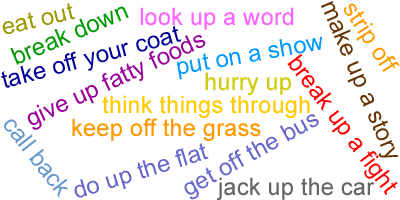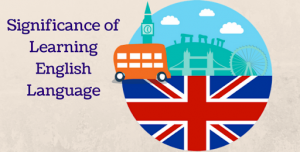There’s a lot written about phrasal verbs, and that’s because there are a lot of phrasal verbs!
Phrasal verbs are one of the hardest aspects of English to learn. The grammar is quite simple, but there are so many of them that most students get overwhelmed. In reality, they are just another part of English vocabulary.
What is a phrasal verb?
 A phrasal verb is an expression that shows an action and is formed of a verb and at least one preposition or particle (but it could be more than one). The thing that makes phrasal verbs special is that they have a meaning that is different from the original ones of the verb and the preposition.
Phrasal verbs can be literal, when we can guess the meaning from the different words: sit down. They can be metaphorical, when we can guess the meaning but it’s not literal: cut down on. Or they can be idiomatic, when the meaning cannot be guessed at all: put up with.
Most phrasal verbs are idiomatic. And that’s why they are so hard for English learners.
Luckily, the Callan Method doesn’t expect you to learn lists of phrasal verbs. You will find them as you move through the books and you will learn to use them in a natural way.
The grammar of phrasal verbs
Phrasal verbs can be transitive or intransitive. Intransitive means that they don’t have an object (the action doesn’t affect anything else): ‘I’m going back home’. Transitive means that they need an object (the thing or person that is affected by the action): ‘I’ll look after the dog‘.
Transitive phrasal verbs can also be separable or inseparable. Inseparable ones need to always stay together: ‘we ran into each other’. Separable phrasal verbs can have their object in the middle or the end: ‘turn off the lights’ or ‘turn them off’.
Separable phrasal verbs can be a bit tricky when it comes to word order. If you are using the full name of the thing it can go at the end or the middle, if you are using a pronoun then it can only be in the middle. For example:
A phrasal verb is an expression that shows an action and is formed of a verb and at least one preposition or particle (but it could be more than one). The thing that makes phrasal verbs special is that they have a meaning that is different from the original ones of the verb and the preposition.
Phrasal verbs can be literal, when we can guess the meaning from the different words: sit down. They can be metaphorical, when we can guess the meaning but it’s not literal: cut down on. Or they can be idiomatic, when the meaning cannot be guessed at all: put up with.
Most phrasal verbs are idiomatic. And that’s why they are so hard for English learners.
Luckily, the Callan Method doesn’t expect you to learn lists of phrasal verbs. You will find them as you move through the books and you will learn to use them in a natural way.
The grammar of phrasal verbs
Phrasal verbs can be transitive or intransitive. Intransitive means that they don’t have an object (the action doesn’t affect anything else): ‘I’m going back home’. Transitive means that they need an object (the thing or person that is affected by the action): ‘I’ll look after the dog‘.
Transitive phrasal verbs can also be separable or inseparable. Inseparable ones need to always stay together: ‘we ran into each other’. Separable phrasal verbs can have their object in the middle or the end: ‘turn off the lights’ or ‘turn them off’.
Separable phrasal verbs can be a bit tricky when it comes to word order. If you are using the full name of the thing it can go at the end or the middle, if you are using a pronoun then it can only be in the middle. For example:
 A phrasal verb is an expression that shows an action and is formed of a verb and at least one preposition or particle (but it could be more than one). The thing that makes phrasal verbs special is that they have a meaning that is different from the original ones of the verb and the preposition.
Phrasal verbs can be literal, when we can guess the meaning from the different words: sit down. They can be metaphorical, when we can guess the meaning but it’s not literal: cut down on. Or they can be idiomatic, when the meaning cannot be guessed at all: put up with.
Most phrasal verbs are idiomatic. And that’s why they are so hard for English learners.
Luckily, the Callan Method doesn’t expect you to learn lists of phrasal verbs. You will find them as you move through the books and you will learn to use them in a natural way.
The grammar of phrasal verbs
Phrasal verbs can be transitive or intransitive. Intransitive means that they don’t have an object (the action doesn’t affect anything else): ‘I’m going back home’. Transitive means that they need an object (the thing or person that is affected by the action): ‘I’ll look after the dog‘.
Transitive phrasal verbs can also be separable or inseparable. Inseparable ones need to always stay together: ‘we ran into each other’. Separable phrasal verbs can have their object in the middle or the end: ‘turn off the lights’ or ‘turn them off’.
Separable phrasal verbs can be a bit tricky when it comes to word order. If you are using the full name of the thing it can go at the end or the middle, if you are using a pronoun then it can only be in the middle. For example:
A phrasal verb is an expression that shows an action and is formed of a verb and at least one preposition or particle (but it could be more than one). The thing that makes phrasal verbs special is that they have a meaning that is different from the original ones of the verb and the preposition.
Phrasal verbs can be literal, when we can guess the meaning from the different words: sit down. They can be metaphorical, when we can guess the meaning but it’s not literal: cut down on. Or they can be idiomatic, when the meaning cannot be guessed at all: put up with.
Most phrasal verbs are idiomatic. And that’s why they are so hard for English learners.
Luckily, the Callan Method doesn’t expect you to learn lists of phrasal verbs. You will find them as you move through the books and you will learn to use them in a natural way.
The grammar of phrasal verbs
Phrasal verbs can be transitive or intransitive. Intransitive means that they don’t have an object (the action doesn’t affect anything else): ‘I’m going back home’. Transitive means that they need an object (the thing or person that is affected by the action): ‘I’ll look after the dog‘.
Transitive phrasal verbs can also be separable or inseparable. Inseparable ones need to always stay together: ‘we ran into each other’. Separable phrasal verbs can have their object in the middle or the end: ‘turn off the lights’ or ‘turn them off’.
Separable phrasal verbs can be a bit tricky when it comes to word order. If you are using the full name of the thing it can go at the end or the middle, if you are using a pronoun then it can only be in the middle. For example:
- Turn off the lights CORRECT
- Turn the lights off CORRECT
- Turn them off CORRECT
- Turn off them INCORRECT






